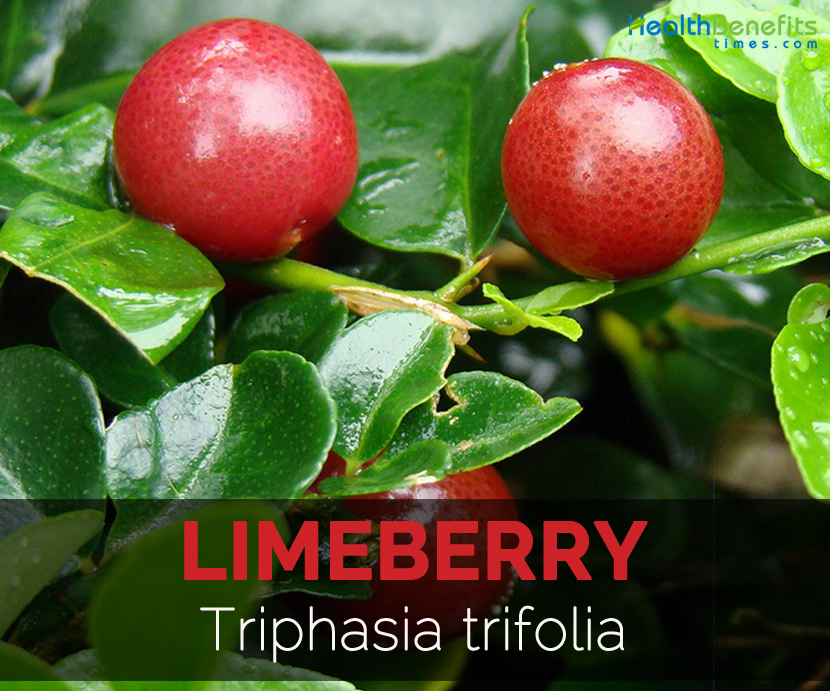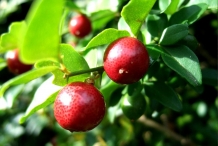History
It is believed to have originated from China or Southeast Asia. It was an anciently introduced to Peninsular Malaysia which has been recently naturalized. It was naturalized and introduced in Thailand and Philippines or Tropical Asia. Now it is widely introduced in Subtropical to Tropical countries. It is also naturalized on Islands in the Pacific.
Plant
Limeberry is a spiny, erect, glabrous and evergreen tree up to 1-3 (-7) m in height. The leaves are glossy, trifoliate, dark green; 1.5-2 cm broad and 2-4 cm long. It has cylindrical buds of size 10-12 X 3-4 mm. The white flowers are fragrant, cup shaped; 4 mm broad and 10-13 mm long that turns to dull reddish to orange or crimson fruit. Fruits are ovoid, subglobose berry, fleshy, 1.2-1.5 cm across and 10-15 mm in diameter. The fruit possess 1 to 3 flattened seeds of 1-3 mm long.
Health benefits of Limeberry
Limeberry is an edible fruit having a sweet taste that could be made as jams and pickled. It possess high amount of nutrients that helps to maintain the good health. The leaves are used to treat colic, diarrhea and skin ailments. The fruit are useful for cough and sore throat. It assist in weight loss, digestion, skin health, provide relief from constipation, scurvy, eye health, respiratory ailments, peptic ulcer, gout, urinary disorders etc.
Traditional uses
- In Philippines, the leaves are used to make aromatic bath salts.
- In Indonesia, the leaves are used to treat the health complaints such as colic, diarrhea and skin diseases.
- It is also used in cosmetics.
- Limeberry is used in traditional medicine of South East Asia.
- The plant is believed to possess antibacterial and antifungal properties which help to treat diarrhea, colic and skin ailments.
- Fruits are useful for sore throats and coughs.
- Fruits should be peeled and soaked the lime water overnight. Then rinse and boil in about 1 cup water along with ½ cup of sugar. It should be rinsed and boiled second or third time as needed for the sore throat and cough.
- The crushed leaves are applied to treat dandruff.
- Fruit is cooked with sugar and water in Guyana as an aid for coughs which helps to loosen phlegm.
Precautions
- Some might get allergic reactions with its use.
- It should be consumed in moderate amounts.
How to Eat
- The ripened fruits are consumed raw, candied or made preserves, marmalade, jams, pickles and beverages.
- Fruits are consumed raw or cooked.
References:
http://www.hear.org/pier/species/triphasia_trifolia.htm
https://npgsweb.ars-grin.gov/gringlobal/taxonomydetail.aspx?id=40476
http://davesgarden.com/guides/pf/go/107203/
http://www.cabi.org/isc/datasheet/108011
http://www.stuartxchange.org/Limonsito.html
http://www.fruitsinfo.com/lime-berry.php
https://en.wikipedia.org/wiki/Triphasia_trifolia
Comments
comments
| Limeberry Quick Facts | |
|---|---|
| Name: | Limeberry |
| Scientific Name: | Triphasia trifolia |
| Origin | It is believed to have originated from China or Southeast Asia. |
| Colors | Dull reddish to orange or crimson (Fruit) |
| Shapes | Ovoid, subglobose berry, fleshy, Across: 1.2-1.5 cm; Diameter: 10-15 mm (Fruit) |
| Flesh colors | Crimson (Fruit) |
| Taste | Acid sweet |
| More facts about Limeberry | |






